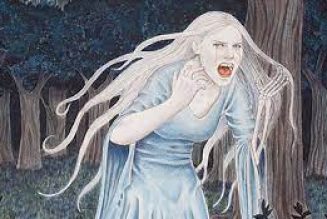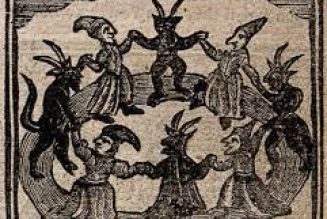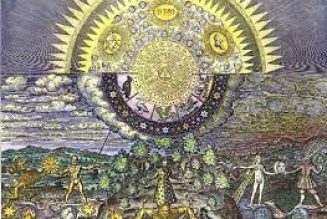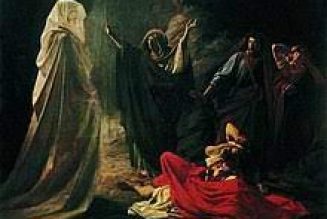This name was given to the statue of a mysterious deity alleged to be worshipped by the Knights Templars.
The latter, although a powerful and wealthy order of chivalry, came to be distrusted by Church and State at the beginning of the fourteenth century, and were disbanded.
They were accused of heresy, of worshipping the Devil in the guise of Baphomet, and of practising homosexuality.
The order was put down with the utmost severity, and its Grand Master, Jacques de Molay, burned at the stake.
The accounts given of this mysterious statue, by the accused Templars when they were brought to trial, are confused. Some of their evidence
was extracted under torture, by people who were determined to get evidence that the Templars were secret devil-worshippers.
Sometimes the image was said to be simply a head but of terrifying aspect, and sometimes merely a bare skull ; but another account told of the figure being worshipped by kissing its feet.
Sometimes it is described as bearded, and “like a demon” ; but it is also described as being like a woman.
It was generally agreed, however, that the image, or what it represented, was worshipped, and that it was regarded as the giver of abundance and fertility.
In 1816 a distinguished antiquarian, Baron Joseph Von HammerPurgstall, published a book entitled Mysterium Baphometis Revelatum,
in which he gave his opinion that the Knights Templars really were secret heretics, or “Gnostics” as he called them.
He based this opinion upon certain very curious relics of thirteenth-century art, consisting chiefly of statuettes, coffers and cups or goblets.
These contained mysterious figures, which are evidently pagan, and correspond to the descriptions of ‘Baphomet’ secretly worshipped by the Templars.
That is, the figures are androgynous, bearded but with female breasts, or otherwise showing the characteristics of both sexes, and often with a skull at the feet, and displaying the magical sigil of the pentagram.
Sometimes inscriptions in Arabic accompany the figures ; but their sense is deliberately obscure.
These images have certain things in common with the deities of the witches.
They are sources of life and fertility, and they are associated with the symbols of the skull and the five-pointed star.
Their sexual characteristics are emphasised, as were those of Pan and the goddesses of Nature.
Their generally pagan appearance would certainly have caused the medieval Church to regard them as devils.
Thomas Wright, in his “Essays on the Worship of the Generative Powers during the Middle Ages of Western Europe” (in Payne Knight’s Discourse on the Worship of Priapus, privately printed, London, 1 865), gives his opinion that : the comparison of facts stated in the confessions of many of the Templars, as preserved in the official reports, with the images and sculptured cups and coffers given by Von Hammer-Purgstall, leads to the conclusion that there is truth in the explanation he gives of the latter, and that the Templars, or at least some of them, had secretly adopted a form of the rites of Gnosticism, which was itself founded upon the phallic worship of the ancients.
An English Templar, Stephen de Staplebridge, acknowledged that ‘there were two professions in the order of the Temple, the first lawful and good, the second contrary to the faith’ .
He had been admitted to the first of these when he entered the order, eleven years before the time of his examination, but he was only initiated into the second or inner mysteries about a year afterwards.
The existence of an inner circle within an order or society of some kind, is a frequent means of occult organisation. Many such ‘orders
within orders’ exist at the present day.
In medieval times, the Devil was often regarded as being androgynous.
The card called ‘The Devil’ in the old pack of the Tarot de Marseilles represents him thus; and the Old English word ‘scrat’ meant both a devil and a hermaphrodite.
‘The Old Scrat’ is still a dialect term for the Devil.
The distinguished nineteenth-century French occultist, Eliphas Levi, declared Baphomet of the Templars to be identical with the god of the
witches’ Sabbat ; it was not the figure of a devil, however, but of the god Pan, or rather a pantheistic symbol of the whole of Nature.
The word Baphomet, when written backwards “Kabbalistically”, reveals three abbreviations : TEM, OHP, AB, which stand for Templi omnium hominum pacis abbas, “The father of the temple of universal peace among men.”
This explanation may sound somewhat far-fetched ; but Eliphas Levi was in touch with secret occult fraternities which preserved traditional knowledge, though he often wrote in an obscure and devious style, being anxious not to give too much offence to the Catholic Church.
There is a very curious and interesting carving in the church of SaintMerri in France, which is traditionally said to be a representation of
Baphomet.
It is a horned and winged figure, bearded but having female breasts; and it sits cross-legged, rather like the old Gaulish figures of the Celtic Horned God, Cernunnos.
The idea that God, containing all things, was therefore androgynous, is a very ancient and widespread one.
It occurs in the collection of magical legends of the witches of ltaly, which Charles Godfrey Leland published as Aradia: The Gospel of the Witches.
In this, the legend of Diana states: “Diana was the first created before all creation ; in her were all things; out of herself, the first darkness, she divided herself; into darkness and light she was divided.
Lucifer, her brother and son, herself and her other half, was the light.”
The same idea occurs in the mystical symbolism of the Qabalah. The Sephiroth, or Divine Emanations from the Unmanifest, which are
arranged as the Qabalistic Tree of Life, represent the attributes of God ; and of these some are male and some female.
S. L. MacGregor Mathers, in The Kabbalah Unveiled (Routledge & Kegan Paul, London, 1957), has pointed out how the translators of the Bible have “smothered up” and glossed over every reference to the fact that God is both masculine and feminine.
This was, of course, done to establish the patriarchal conception of God the Father, with femininity regarded, after the Pauline fashion, as something inferior if not actually evil.
However, in the Ancient East the highest deities were sometimes represented in androgynous form.
Such figures were called Brahma Ardhanarisa, or Shiva Ardhanarisa.
The Syrian god Baal was sometimes represented as double-sexed ; and old accounts tell us that his worshippers called upon him thus : “Hear us, Baal ! Whether thou be god or goddess!” Mithras was sometimes referred to as androgynous; and the Greek Dionysus even more frequently so.
One of his titles was Diphues, meaning ‘double-sexed’. The Orphic Hymns sing of Zeus, the supreme god of nature, in the same way ; as man and as virgin eternal.
Goddesses, too, were sometimes regarded in the ancient world as double-sexed ; in particular, the most supposedly feminine of them all,
Venus or Aphrodite.
In Cyprus, a strange image of Venus was worshipped, bearded and masculine, but dressed in female attire.
At the festivals of this worship, transvestism was practised, women wearing men’s clothes and men dressing as women. Similar festivals honoured the goddess Astarte ; and it is interesting to note that transvestism was condemned by the Christian Church, which associated it with witchcraft.
There seems no particular reason why transvestism should be regarded as wicked, when one comes to think of it.
It is probable that the real cause of the Christian and Old Testament denunciations of the practice, lies in the fact that it was a custom carried out in honour of pagan deities.
The figure of Baphomet, therefore, is connected with worship of great antiquity, the depth and widespread nature of which have been little
realised, on account of the veil which has been drawn over these matters.
Only in the present day has this veil of pudeur begun to be lifted, when people have come to realise that the ‘obscenity’ of the old Nature
worship was mostly in the eye of the beholder.








